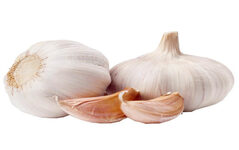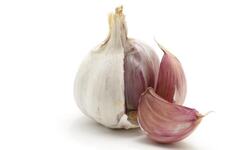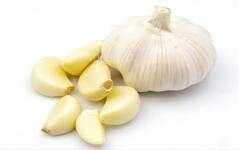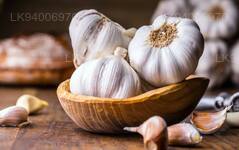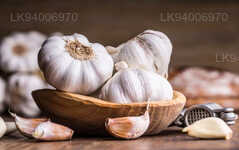
Ayurvedic Medicinal Plants
Sri Lanka's Ayurvedic tradition features a rich variety of medicinal plants used for centuries. Sri Lanka has a rich tradition of Ayurvedic medicine, drawing on its indigenous knowledge and a variety of medicinal plants. Here are some notable Ayurvedic medicinal plants found in Sri Lanka:
Allium sativum; සුදුළුණු
Allium is a genus of monocotyledonous flowering plants that includes hundreds of species, including the cultivated onion, garlic, scallion, shallot, leek, and chives. The generic name Allium is the Latin word for garlic,and the type species for the genus is Allium sativum which means "cultivated garlic"
Carl Linnaeus first described the genus Allium in 1753. Some sources refer to Greek ἀλέω (aleo, to avoid) by reason of the smell of garlic. Various Allium have been cultivated from the earliest times, and about a dozen species are economically important as crops, or garden vegetables, and an increasing number of species are important as ornamental plants
Allium species occur in temperate climates of the Northern Hemisphere, except for a few species occurring in Chile (such as A. juncifolium), Brazil (A. sellovianum), and tropical Africa (A. spathaceum). They vary in height between 5 cm and 150 cm. The flowers form an umbel at the top of a leafless stalk. The bulbs vary in size between species, from small (around 2–3 mm in diameter) to rather large (8–10 cm). Some species (such as Welsh onion A. fistulosum and leeks (A. ampeloprasum)) develop thickened leaf-bases rather than forming bulbs as such.
Allium species occur in temperate climates of the Northern Hemisphere, except for a few species occurring in Chile (such as A. juncifolium), Brazil (A. sellovianum), and tropical Africa (A. spathaceum). They vary in height between 5 cm and 150 cm. The flowers form an umbel at the top of a leafless stalk. The bulbs vary in size between species, from small (around 2–3 mm in diameter) to rather large (8–10 cm). Some species (such as Welsh onion A. fistulosum and leeks (A. ampeloprasum)) develop thickened leaf-bases rather than forming bulbs as such.
Plants of the genus Allium produce chemical compounds, mostly derived from cysteine sulfoxides, that give them a characteristic onion or garlic taste and odor.Many are used as food plants, though not all members of the genus are equally flavorful. In most cases, both bulb and leaves are edible. The characteristic Allium flavor depends on the sulfate content of the soil the plant grows in. In the rare occurrence of sulfur-free growth conditions, all Allium species completely lose their usual pungency.
In the APG III classification system, Allium is placed in the family Amaryllidaceae, subfamily Allioideae (formerly the family Alliaceae). In some of the older classification systems, Allium was placed in Liliaceae.Molecular phylogenetic studies have shown this circumscription of Liliaceae is not monophyletic.
Allium is one of about fifty-seven genera of flowering plants with more than 500 species.It is by far the largest genus in the Amaryllidaceae, and also in the Alliaceae in classification systems in which that family is recognized as separate
-

Ankenda
Acronychia pedunculata -

Beli
Aegle marmelos -

Bakmi
Nauclea orientalis -

Bangwel-geta
Coscinium fenestratum -

Bukinda /Walkinda
Tinospora malabarica -

Bu- kobbe
Allophylus cobbe -

Dodan –kaha
Memecylon capitellatum -

Diyamitta
Cissampelos pareira -

Embul dodan
Citrus aurantium -

Gas nidikumba
Biophytun reinward -

Hintambala
Carmona microphylla -

Goraka
Garcinia cambogia -

Karapincha
Murraya koenigii -

Keppetiya
Croton laccifer -

Kohomba
Azadirachta indica -

Kotikan-bevila
Sida alba -

Kudumiris (Forest paper)
Toddlia asiatica -

Kurundu
Cinnamomum zeylanicum -

Mahakaramba
Carissa carandas -

Muna mal
Mimusops elengi -

Nelli
Phyltanthus emblica -

Puwak
Areca catechu -

Rath mal
Ixora coccinea -

Eepatta / Ruk - anguna
Alangium salviifolium -

Siyambala
Tamarindus indica -

Walangasal / Wal-embilla
Embelia ribes -

Wal Karapincha
Micromelum ceylanicum -

Welangiriya
Paramignya monophylla
Ayurvedic and Herbal
-
Siddhalepa Ayurveda Herbal Balm
Regular price From Rs. 100.00Regular priceUnit price / perRs. 100.00Sale price From Rs. 100.00 -
Lakpura Wildcrafted Soursop (Guanabana, Graviola, Guyabano) Dehydrated Leaves Whole
Regular price From Rs. 300.00Regular priceUnit price / perRs. 200.00Sale price From Rs. 300.00 -
Link Swastha Triphala
Regular price From Rs. 200.00Regular priceUnit price / perRs. 200.00Sale price From Rs. 200.00 -
Sethsuwa Pranajeewa Oil
Regular price From Rs. 300.00Regular priceUnit price / perRs. 400.00Sale price From Rs. 300.00Sale

